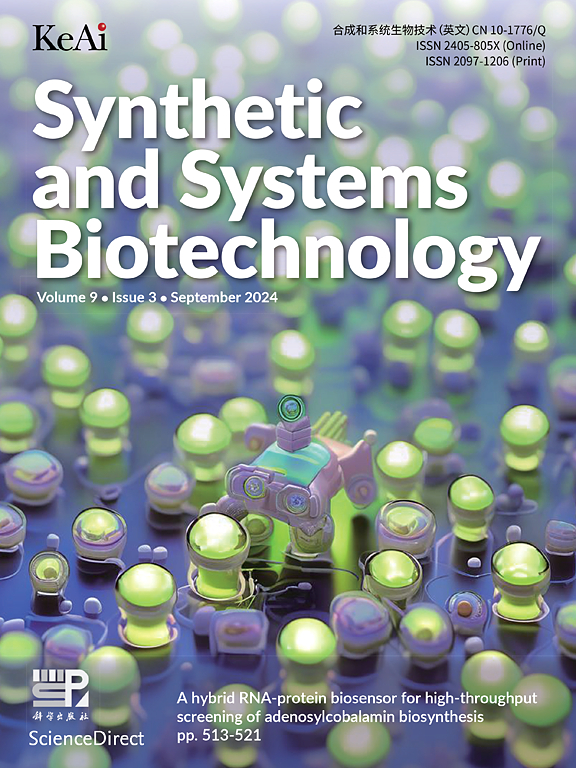T7 RNA polymerase-guided base editor for accelerated continuous evolution in Bacillus subtilis
IF 4.4
2区 生物学
Q1 BIOTECHNOLOGY & APPLIED MICROBIOLOGY
引用次数: 0
Abstract
Targeted in vivo hypermutation mediated by base deaminase-T7 RNA polymerase (T7 RNAP) fusions promotes genetic diversification and accelerates continuous directed evolution. Due to the lack of a T7RNAP expression regulation system and functionally compatible linker for fusion protein expression, T7RNAP-guided continuous evolution has not been established in Bacillus subtilis, which limited long gene fragment continuous evolution targeted on genome. Here, we developed BS-MutaT7 system, which introduced mutations into specific genomic regions by leveraging chimeric fusions of base deaminases with T7RNAP in B. subtilis. We selected seven different sources of adenosine and cytosine deaminases, 14 fusion protein linkers to be fused with T7RNAP, constructing four libraries with the size of 5000, where deaminases were fused at either the N- or C-terminus of T7RNAP. Based on the efficiency of binding to T7 promoter and high mutagenesis activity, two optimal chimeric mutators, BS-MutaT7A (TadA8e-Linker0-T7RNAP) and BS-MutaT7C (PmCDA1-(GGGGS)3-T7RNAP co-expressed with UGI) were identified. The target mutation rates reached 1.2 × 10−5 per base per generation (s.p.b.) and 5.8 × 10−5 s.p.b., representing 7000-fold and 37,000-fold increases over the genomic mutation rate, respectively. Both exhibited high processivity, maintaining mutation rates of 5.8 × 10−6 s.p.b. and 2.9 × 10−5 s.p.b. within a 5 kb DNA region. Notably, BS-MutaT7C exhibited superior mutagenic activity, making it well-suited for applications requiring intensive and sustained genomic diversification. Application of BS-MutaT7 enabled a 16-fold increase in tigecycline resistance and enhanced β-lactoglobulin (β-Lg) expression by evolving the global transcriptional regulator codY, achieving a β-Lg titer of 3.92 g/L. These results highlight BS-MutaT7 as a powerful and versatile tool for genome-scale continuous evolution in B. subtilis.
T7 RNA聚合酶引导的加速枯草芽孢杆菌持续进化的碱基编辑器
碱基脱氨酶-T7 RNA聚合酶(T7 RNAP)融合介导的体内靶向高突变促进了遗传多样化,加速了持续的定向进化。由于缺乏T7RNAP表达调控系统和功能兼容的融合蛋白表达连接体,在枯草芽孢杆菌中尚未建立T7RNAP引导的连续进化,限制了针对基因组的长基因片段连续进化。在这里,我们开发了BS-MutaT7系统,该系统通过利用枯草芽孢杆菌中碱基脱氨酶与T7RNAP的嵌合融合,将突变引入特定的基因组区域。我们选择了7个不同来源的腺苷和胞嘧啶脱氨酶,14个融合蛋白连接体与T7RNAP融合,构建了4个大小为5000的文库,其中脱氨酶分别融合在T7RNAP的N端或c端。基于与T7启动子的结合效率和较高的诱变活性,确定了两个最佳嵌合突变子BS-MutaT7A (TadA8e-Linker0-T7RNAP)和BS-MutaT7C (PmCDA1-(GGGGS)3-T7RNAP)与UGI共表达。目标突变率达到1.2 × 10−5个碱基每代(sps)和5.8 × 10−5 sps .b,分别比基因组突变率提高了7000倍和37000倍。两者均表现出较高的处理性,在5kb DNA区域内的突变率分别为5.8 × 10−6和2.9 × 10−5。值得注意的是,BS-MutaT7C表现出优异的诱变活性,使其非常适合需要密集和持续基因组多样化的应用。应用BS-MutaT7,通过进化全局转录调节因子codY,使替加环素耐药性增加16倍,β-乳球蛋白(β-Lg)表达增强,β-Lg滴度达到3.92 g/L。这些结果表明BS-MutaT7是枯草芽孢杆菌基因组尺度连续进化的强大和通用工具。
本文章由计算机程序翻译,如有差异,请以英文原文为准。
求助全文
约1分钟内获得全文
求助全文
来源期刊

Synthetic and Systems Biotechnology
BIOTECHNOLOGY & APPLIED MICROBIOLOGY-
CiteScore
6.90
自引率
12.50%
发文量
90
审稿时长
67 days
期刊介绍:
Synthetic and Systems Biotechnology aims to promote the communication of original research in synthetic and systems biology, with strong emphasis on applications towards biotechnology. This journal is a quarterly peer-reviewed journal led by Editor-in-Chief Lixin Zhang. The journal publishes high-quality research; focusing on integrative approaches to enable the understanding and design of biological systems, and research to develop the application of systems and synthetic biology to natural systems. This journal will publish Articles, Short notes, Methods, Mini Reviews, Commentary and Conference reviews.
 求助内容:
求助内容: 应助结果提醒方式:
应助结果提醒方式:


